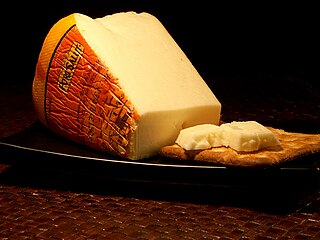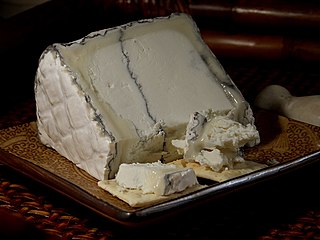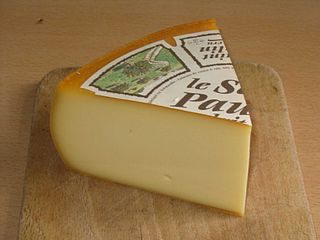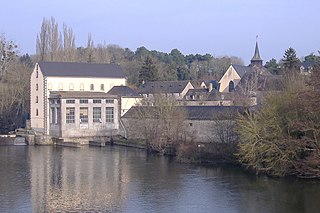
Port Salut is a semi-soft pasteurised cow's milk cheese from Pays de la Loire, France, with a distinctive orange rind and a mild flavour. The cheese is produced in wheels approximately 23 cm (9 inches) in diameter, weighing approximately 2 kg (4.4 lb).

Brie is a soft cow's-milk cheese named after Brie, the French region from which it originated. It is pale in color with a slight grayish tinge under a rind of white mould. The rind is typically eaten, with its flavor depending largely upon the ingredients used and its manufacturing environment. It is similar to Camembert, which is native to a different region of France. Brie typically contains between 60% and 75% butterfat, slightly higher than Camembert.

Chaumes is a cow's milk cheese from Saint-Antoine-de-Breuilh in the Périgord, made by traditional cheese-making processes. Translated literally, "chaumes" is French for stubble.

Camembert is a moist, soft, creamy, surface-ripened cow's milk cheese. It was first made in the late 18th century in Camembert, Normandy, in northwest France. It is sometimes compared in look and taste to brie cheese, albeit with a slightly lower butterfat content than brie's typically 20% - 25% by weight.

Humboldt Fog is a goat milk cheese made by Cypress Grove, of Arcata, California, in Humboldt County. It is named for the local ocean fog which rolls in from Humboldt Bay. It is an uncooked pressed cheese made from pasteurized goat's milk.

Abbaye de Belloc is a French Pyrenees semi-hard cheese from the Pays Basque region, made from unpasteurized sheep milk.

Bleu Bénédictin is a Canadian blue cheese made by the monks at the Benedictine Abbey of Saint-Benoît-du-Lac, Quebec.

Pont-l'Évêque is a French cheese, originally manufactured in the area around the commune of Pont-l'Évêque, between Deauville and Lisieux in the Calvados département of Normandy. It is probably the oldest Norman cheese still in production.

Esrom, or Danish Port Salut cheese is a Trappist-style pale yellow semi-soft cow's milk cheese with a pungent aroma and a full, sweet flavour.

Saint Paulin is a creamy, mild, semi-soft French cheese made from pasteurized cow's milk, originally made by Trappist monks at Saint Paulin. It is a buttery cheese, but firm enough for slicing. Saint Paulin is similar to Havarti and Esrom, and is suited to serving as a table or dessert cheese; it is often served with fruit and light wine. Genuine Saint Paulin has an edible yellow-orange rind. It is ripened in a round loaf with slightly protruding sides, and matures in about four weeks.
The Abbey of Notre-Dame du Lac, known as the Oka Abbey, was a Trappist Cistercian monastery located in Oka, Quebec. The main monastery building is of grey stone; it has a dozen outbuildings, all of which are situated on a 270-hectare property. With a decline in the number of monks by the early 21st century, the monastery decided to end operations there and established a non-profit centre at the abbey to preserve the site's heritage.

Scourmont Abbey is a Trappist monastery on the Scourmont plateau, in the village of Forges which is part of Chimay in the province of Hainaut, Belgium. The abbey is famous for its spiritual life and for running the Chimay Brewery, one of the few producers of Trappist beer.

There are many different types of cheese. Cheeses can be grouped or classified according to criteria such as length of fermentation, texture, methods of production, fat content, animal milk, and country or region of origin. The method most commonly and traditionally used is based on moisture content, which is then further narrowed down by fat content and curing or ripening methods. The criteria may either be used singly or in combination, with no single method being universally used.
Bonne Bouche is an aged goat's milk cheese made by Vermont Creamery, of Websterville, Vermont, United States. "Bonne bouche" is French for "tasty bite".

Port-du-Salut Abbey, also the Abbey of Notre-Dame du Port du Salut is a Trappist monastery located in Entrammes, Mayenne, France. The main monastery building dates from around the 13th century.

Trappista is a traditional semi-hard cow's-milk cheese made in France, Belgium, Bosnia and Herzegovina and Hungary. It was created by the Trappist monks of Port-du-Salut Abbey in France.

The Pikauba is a semi-firm cheese, farmer made by hand, in the region Saguenay–Lac-Saint-Jean in Quebec. It takes its name from a river, Pikauba River, that crosses the Laurentides Wildlife Reserve.

Abbaye de Timadeuc Cheese is a cheese produced in a monastery by Trappist monks. This cow's milk cheese is an uncooked pressed cheese.
















